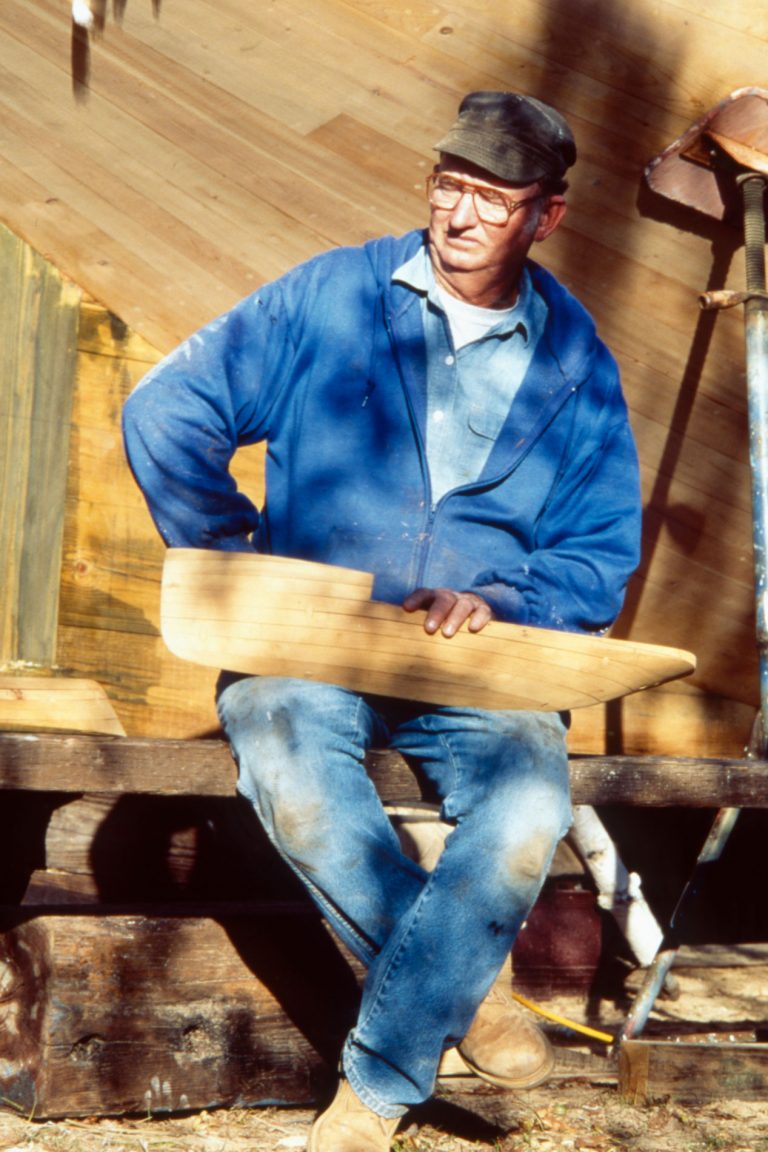Bill Holland was born in Biloxi, Mississippi in 1946 and grew up in its Back Bay neighborhood. The area was home to many of the city’s boatyards and seafood canning factories. His mother worked in the plants and his father served as a schooner captain. Holland grew up playing around the various boatyards in his neighborhood, watching the men build and repair the local fishing boats. He got started building model boats made from scrap wood from the yards. By the time he was twelve he had built his first boat and had begun working in the boatyards, learning the trade from the builders. During his teenage years, Holland worked for a number of Biloxi’s renowned wooden boatbuilders, including Homer Fayard, Gussie Fountain, his uncle Walter D’Orville, and Frank Guitierrez.
After a stint in the Coast Guard, Holland learned about the construction of steel hull ships through work as a production welder and burner at the Ingalls Shipyard in Pascagoula. Later he purchased a piece of waterfront property across the bay from Biloxi in D’Iberville, a spot that had been known for over 100 years as Shipyard Point. Holland built his own boatyard on the property, along with a home for his family.
Holland builds and repairs a wide range of boats in his yard, from small skiffs and sailboats to large schooners. He has built 43 boats in his lifetime. Although he has done a wide range of work, his favorite projects are constructing new boats using the older forms and designs. One of his more recent projects in this vein was Mascot, a 39-foot steam launch built for a New Orleans businessman.
One of the most well-known boats that Holland has built is the Glen L. Swetman, a 68-foot Biloxi Schooner owned and operated by the Maritime and Seafood Industry Museum of Biloxi (see image gallery). The Biloxi Schooner was a distinctive type of boat constructed by local builders for the fishermen of the area. It was built to negotiate the shallow waters of the Gulf, handle large catches, and be fast under sail. As he does in all of his work, Holland used the traditional building techniques of the area in the construction of the Glen L. Swetman. The boat is fully equipped with sails (as well as a diesel motor) and is used extensively by the museum in a variety of programs and excursions. It functions as an important physical link for the people of Biloxi to their past.
In addition to building the Glen L. Swetman, Holland’s work is also featured prominently within the Maritime Museum. The boatbuilding display at the museum features examples of the half models of boat hulls that he makes and uses to create the initial He has also recently completed a special commission for the museum, a cross section of a Biloxi Schooner hull that is currently on display (see slide). This exhibit provides a unique, close-up look at Holland’s precise and detailed work.
Holland is committed to passing on his knowledge to others. In past years he has served as a master artist in the Mississippi Arts Commission’s Folk Arts Apprenticeship Program. He has also worked with a number of people on his own. Holland’s nephew, a former apprentice, is currently working in the boatyard, completing his first wooden boat.
In the early 1990s, casino gaming was legalized for the Mississippi Gulf Coast. This ruling has brought about profound changes for Biloxi and many of the other coastal towns. Several large casino hotel complexes have been built in Biloxi, many of them on the spots where seafood processing plants had once operated. The growth of the gaming industry has resulted in tremendous increases in tax revenues and employment opportunities for the area, but it has also brought about fundamental changes in the community. As Biloxi transforms from a coastal fishing town to a major tourist destination, Bill Holland serves as one of the last links to Biloxi’s significant maritime tradition.
Holland talks about his years learning from master boat builders during his younger days (audio courtesy of Mississippi Educational Network): Audio

